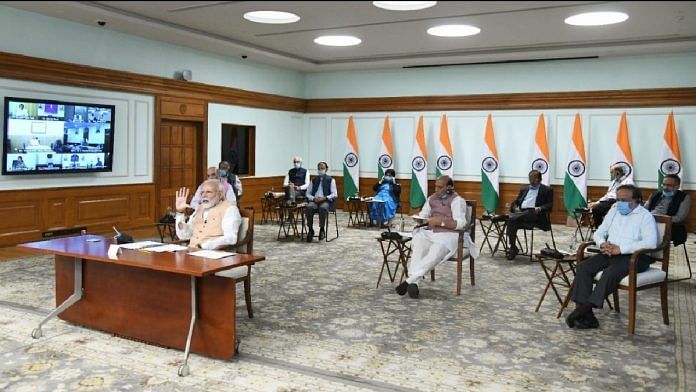According to the International Monetary Fund, India will be the large economy worst hit by the Covid-19 pandemic. The Fund now says that Indian GDP in the ongoing financial year, which began in March 2020, will contract by 4.5%. Just a few weeks ago, it had been predicting 2% growth for the year.
The IMF’s projection is by and large in line with estimates from investment banks and other international organizations. Indian officials have been reticent about their own estimates. This is not surprising: India’s economy has not contracted since 1979. For the government, this is uncharted territory.
A slowdown of this magnitude will have enormous human consequences. By some estimates, the loss of three months’ income would leave nearly half of the country’s population mired in poverty, reversing all the gains made since the economy was liberalized in the early 1990s.
Worse, the government’s finances are strained. Tax revenues are set to crash and India’s hitherto relatively stable debt-to-GDP ratio may spike up toward 90%. Controlling the spread of the pandemic will bleed state resources, leaving little for the welfare measures that will be essential in coming months.
Such economic pressures help explain why the government lifted India’s stringent lockdown even though the spread of Covid-19 clearly hadn’t been controlled. India now has the world’s fourth-largest number of Covid-19 cases. While the country may be partly protected from a tide of deaths by its favorable age distribution, there is every reason to suppose that more lockdowns to protect its inadequate health infrastructure will be required. If nothing else, this complicates predictions for the medium term and makes the task of reviving the economy that much harder.
Also read:How India can buck the trend of global recession caused by coronavirus
But don’t let anyone tell you the pandemic is the main reason India’s growth has gone off a cliff. The economy had already been weakened by years of mismanagement before this crisis struck.
Figures released by national statisticians at the end of May explain what went wrong. Even before the pandemic properly hit India, in the financial year ending in March, GDP only grew at 4.2%. The sequence of quarterly GDP growth numbers leading up to that point tells a clear story: 7% growth shrunk to 6.2%, then to 5.6%, 5.7%, 4.4% and finally 3.1% in the quarter that ended with the lockdown.
What was behind this slowdown? The answer is a lack of investment. Investment shrank by almost 3% over the year. Until then, India hadn’t seen investment shrink for almost two decades, according to World Bank data. (It grew about 10% in 2018-19.) And this shrinkage began well before the pandemic — in April 2019. In India, the virus struck an economy with pre-existing conditions.
The investment crisis and India’s large debt pile have the same cause: a government that thinks its own spending is what will fuel economic growth. According to official statistics, government spending increased by 12% last year, more than twice the growth rate of private consumption. Government spending was similarly higher than the other components of GDP in the previous year as well.
As a consequence, the government last year — again, before the pandemic properly hit — had a fiscal deficit 4.6% higher than the one it inherited six years ago. This is pretty embarrassing, given the government has long claimed that its stewardship had provided macroeconomic stability following the turbulent last years of its predecessor.
This should all be enough to sober any government. Yet, policymakers in New Delhi seem to be oddly sanguine. On Tuesday, they posted a cheerful update praising their “prompt policy measures” and touting an “increase in economic activity.” It’s true that May looked like a better month than April, when the lockdown was at its height. But pretty much every indicator for May 2020 is in the red when compared to May 2019. And most analysts believe any recovery will now take two years or so, rather than a couple of months.
The government’s confidence is inexplicable. It has not done enough to reinvigorate the economy. Its big weapon — spending — has failed and there is little left in its armory. Recovery needs reform. India has postponed competitiveness-enhancing measures long enough. In a crisis of this magnitude, there are no excuses left.- Bloomberg
Also read:World Bank forecasts worst recession in eight decades due to coronavirus




As long as India’s governing economic philosophy remains govermentalism in the garb of socialism, India can never reach it’s potential. In the misguided belief that they know best and must run everything under the sun, Indian governments have severely restricted the ordinary citizen’s economic freedom. Further what doesn’t help is the mistrust in which the government holds it’s subjects. For the government every citizen is an untrustworthy fraud and liar who needs to be constantly subject to scrutiny. So in India if you need to start an enterprise/business/industry you are not viewed as an asset who creates wealth, jobs etc. but as a crook out to exploit. The biggest obstacle to India’s well being and prosperity is the government itself. Time it gets out of the way.
This is the most ideologically driven government since Independence. The results are starkly visible in every domain, led by the economy and foreign policy. The second term – an exceptional mandate secured despite so many disappointments – started not with a determination to swiftly address the advanced malaise in the economy but long cherished goals like abrogation of Article 370. Just a few months back, a retired COAS had said he rated the chances of actual conflict with China as “ low”, now here we are. Among the many things that have gone wrong is a stubborn refusal to allow any form of criticism – quite often it would be well intentioned feedback – or to introspect and correct course. An Arctic ice breaker designed to make a crunching sound as it sails blithely forward.